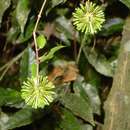en
names in breadcrumbs


Cephalanthus is a genus of flowering plants in the family Rubiaceae. There are about six species that are commonly known as buttonbush.[1][2]
They are shrubs or small trees growing to 5–15 m (16–49 ft) tall. The leaves are simple, arranged in opposite pairs or whorls of three. The flowers form a dense globular inflorescence.
Cephalanthus occidentalis is native to the eastern United States and Canada. The others occur in tropical regions of the Americas, Africa and Asia.[3] Two species are known in cultivation.[4]
Cephalanthus was named by Linnaeus in Species Plantarum in 1753.[5] The generic name is derived from the Ancient Greek words κέφαλη (kephale), meaning "head", and ἄνθος (anthos), meaning "flower".[6]
Cephalanthus is the most basal genus in the tribe Naucleeae.[7] Some authors have segregated it into its own monotypic tribe.[8] The type species is Cephalanthus occidentalis.[9]
16 fossil mericarps of †Chephalanthus pusillus have been described from middle Miocene strata of the Fasterholt area near Silkeborg in Central Jutland, Denmark.[10]
Cephalanthus is a genus of flowering plants in the family Rubiaceae. There are about six species that are commonly known as buttonbush.